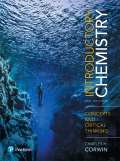
Concept explainers
(a)
Interpretation:
The reactant, acid and base, of salt potassium bromide,
Concept introduction:
According to
Answer to Problem 12E
In the formation of salt potassium bromide,
Explanation of Solution
Acids loses their
The chemical equation is given below.
In the formation of salt potassium bromide,
(b)
Interpretation:
The reactant, acid and base, of salt barium chloride,
Concept introduction:
According to Arrhenius theory, an acid is defined as a species which donates a proton. A base is defined as a species which can donate a hydroxide ion
Answer to Problem 12E
In the formation of salt barium chloride,
Explanation of Solution
Acids loses their
The chemical equation is given below.
In the formation of salt barium chloride,
(c)
Interpretation:
The reactant, acid and base, of salt cobalt (II) sulfate,
Concept introduction:
According to Arrhenius theory, an acid is defined as a species which donates a proton. A base is defined as a species which can donate a hydroxide ion
Answer to Problem 12E
In the formation of salt cobalt (II) sulfate,
Explanation of Solution
Acids loses their
The chemical equation is given below.
In the formation of salt cobalt (II) sulfate,
(d)
Interpretation:
The reactant, acid and base, of salt sodium phosphate,
Concept introduction:
According to Arrhenius theory, an acid is defined as a species which donates a proton. A base is defined as a species which can donate a hydroxide ion
Answer to Problem 12E
In the formation of salt sodium phosphate,
Explanation of Solution
Acids loses their
The chemical equation is given below.
In the formation of salt sodium phosphate,
Want to see more full solutions like this?
Chapter 14 Solutions
EBK INTRODUCTORY CHEMISTRY
- Follow the directions of Question 7 for solutions of the following: (a) silver nitrate and sodium chloride (b) cobalt(II) nitrate and sodium hydroxide (c) ammonium phosphate and potassium hydroxide (d) copper(II) sulfate and sodium carbonate (e) lithium sulfate and barium hydroxidearrow_forwardDetermination Of The Acid Conent In Vinegar -How would the concentration of the vinegar solution be altered if the pipet used to dilute the original concentration of vinegar contained some water?arrow_forwardWhich of the following salts is the salt of a strong base and a strong acid?arrow_forward
- Two 0.10 mol samples of the hypothetical monoprotic acids HA(aq) and HB(aq) are used to prepare 1.0L stock solutions of each acid.write the chemical reactiom for these acids in water and what are the concentrations of the two acid solutions?arrow_forwardIf 18.9 mL of 0.800 M HCl solution are needed to neutralize 5.00 mL of a household ammonia solution, what is the molar concentration of the ammonia?arrow_forwardClassify the following as strong acid or base or weak acid or base.arrow_forward
- Which of the substances have a strong base?arrow_forwardWrite balanced molecular chemical equation for the following acid-base reactions:a. Potassium hydroxide is neutralized by nitric acidb. Hydrochloric acid is neutralized by barium hydroxidearrow_forwardThe pH of a solution is 5.2, what is the [OH] concentration?arrow_forward
- Write an equation to show that hydrochloric acid , HCl , behaves as an acid in water. Write an equation to show that hypochlorous acid , HClO , behaves as an acid in water. Write a net ionic equation to show that phosphoric acid, H3PO4, behaves as an acid in water. Consider only its first ionization.arrow_forwardWhich of the following is not identified as a strong base?arrow_forwardWhat is an abstract of an acid base titration for sodium hydroxide and hydrochloric acid.arrow_forward
 Chemistry: Principles and ReactionsChemistryISBN:9781305079373Author:William L. Masterton, Cecile N. HurleyPublisher:Cengage Learning
Chemistry: Principles and ReactionsChemistryISBN:9781305079373Author:William L. Masterton, Cecile N. HurleyPublisher:Cengage Learning

